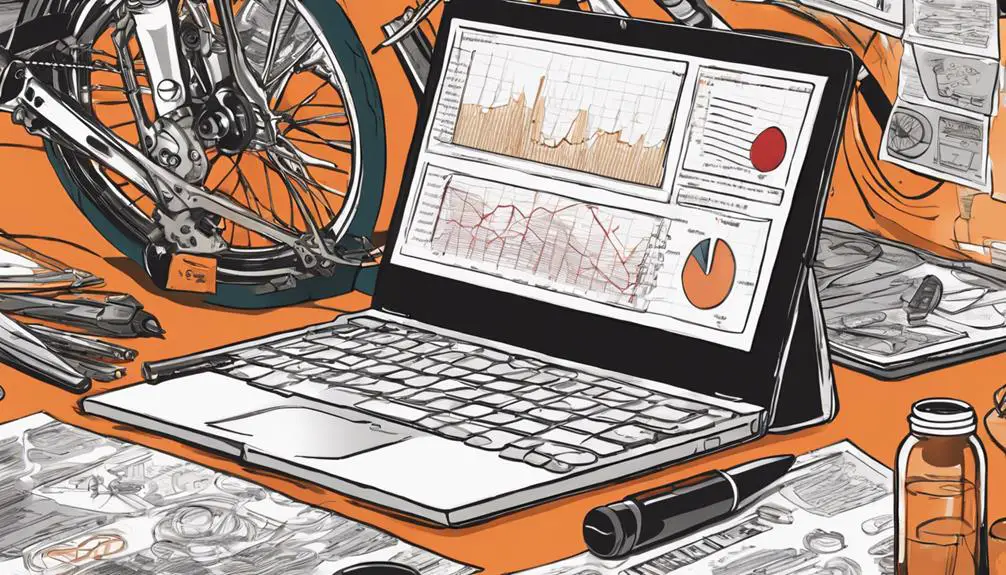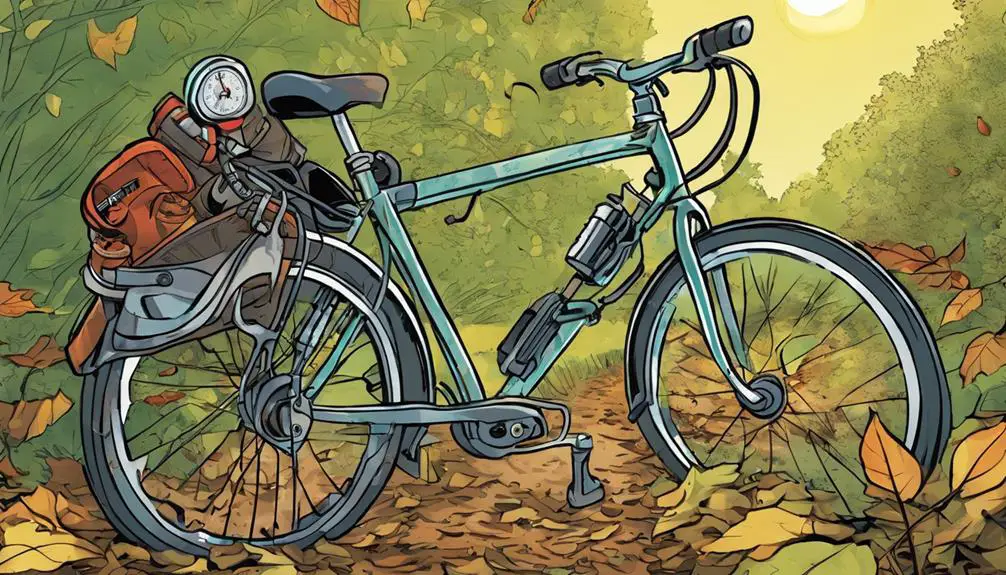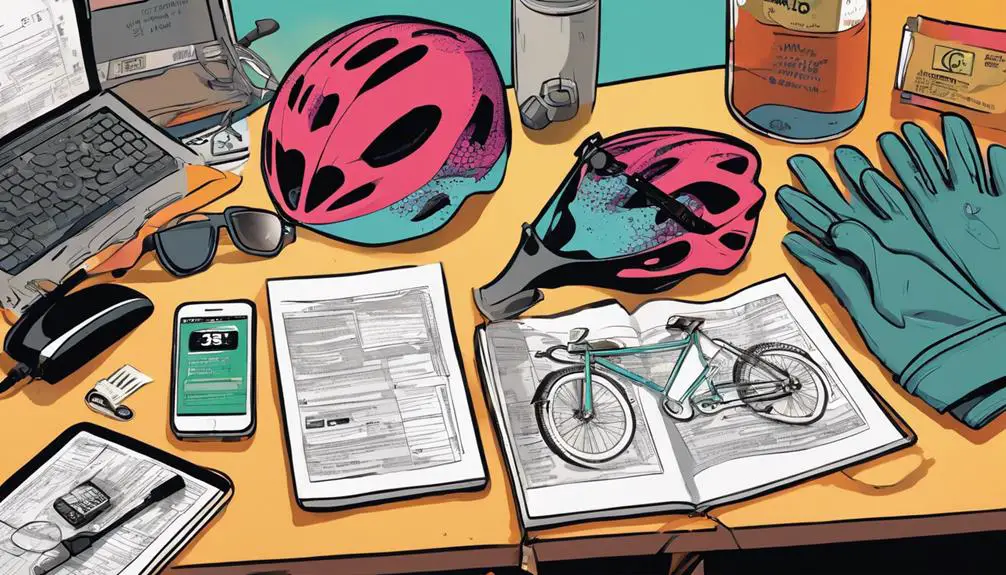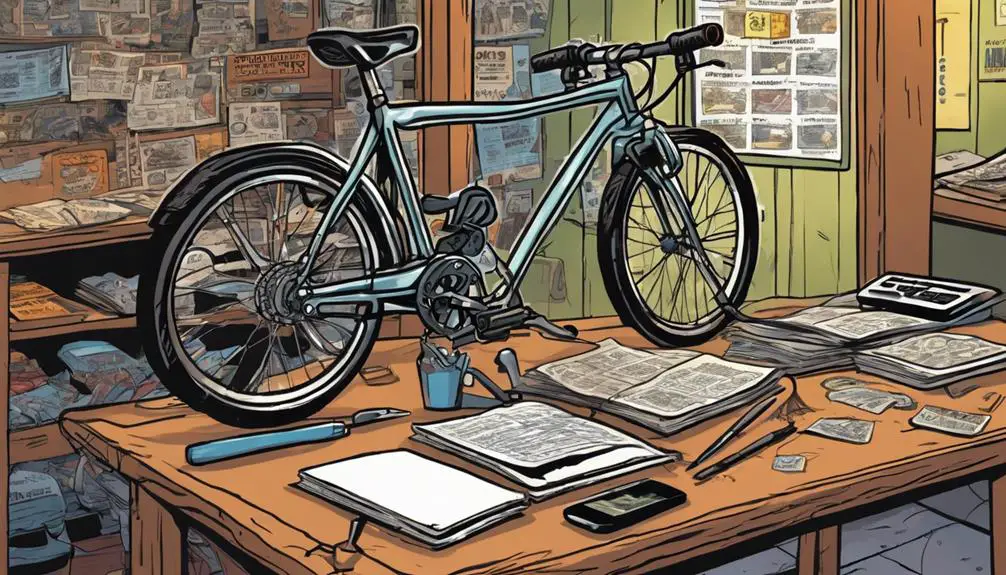When you're ready to sell your bike, knowing its resale value is essential. You'll want to start by researching market trends and evaluating your bike's condition carefully. Don't overlook the impact of mileage and any modifications you've made. By following a systematic approach, you can guarantee you're setting a fair price that attracts buyers. But before you get too far ahead, there are specific steps you should consider to maximize your bike's value—let's explore those next.
Quick Takeaways
- Research comparable bike models online to understand market trends and determine competitive pricing.
- Assess your bike's condition, including frame integrity, component functionality, and overall aesthetics.
- Evaluate tires and brakes for safety, highlighting their condition as a selling point.
- Track mileage and usage, emphasizing low mileage and type of riding to attract buyers.
Research Market Trends

To determine your bike's resale value, you should keep an eye on current market trends to see how similar models are selling.
Start by browsing online marketplaces like Craigslist, eBay, and specialized cycling sites. Look for bikes that are comparable in brand, model, and condition. Take note of their asking prices and how quickly they're selling. This'll give you a clear picture of what buyers are willing to pay.
Next, engage with local cycling groups or forums where enthusiasts gather. These communities often share insights about market fluctuations and demand for specific models. You'll find that some bikes have a cult following, driving up their value, while others may struggle to fetch a good price.
Don't forget to check out social media platforms where bike sales happen. Instagram and Facebook Marketplace can offer valuable data on what's trending.
Ultimately, you're not just selling a bike; you're releasing a piece of your freedom. So, by understanding the market, you empower yourself to get the best value possible, ensuring that someone else can experience the joy of riding and exploring the open road.
Assess Your Bike's Condition
To get an accurate resale value for your bike, you need to assess its condition carefully.
Start by inspecting the frame and components for any damage or wear and tear.
Don't forget to evaluate the tires and brakes, as their condition plays a big role in your bike's overall appeal.
Inspect Frame and Components
Inspecting the frame and components of your bike is essential for accurately evaluating its condition and resale value. Start by closely examining the frame for any dents, scratches, or rust. These imperfections can greatly affect how potential buyers perceive your bike. If you notice any cracks or structural damage, you might need to reconsider your asking price.
Next, check the components like the handlebars, pedals, and drivetrain. Verify they're functioning well and free from excessive wear. Listen for any unusual noises when you spin the pedals or shift gears—these can indicate underlying issues that could deter buyers.
Don't forget to assess the condition of your bike's finish. A well-maintained bike with a clean, shiny surface communicates care and attention, which can boost its appeal.
Also, consider any upgrades or custom components. High-quality parts can enhance resale value, so be sure to highlight these when you list your bike.
Evaluate Tires and Brakes
Evaluating the tires and brakes is just as important as checking the frame and components when appraising your bike's overall condition and resale value.
Tires not only affect your bike's performance but also your safety on the road. Inspect them for tread wear, cracks, or bulges. If they're worn out, replacing them can greatly enhance your bike's appeal to potential buyers.
Next, turn your attention to the brakes. Effective brakes are essential for a smooth ride and your security. Check the brake pads for wear; they should have enough material left to grip effectively.
Squeeze the levers—do they feel responsive? If they're spongy or require excessive force, you might need a brake adjustment or replacement.
Consider Mileage and Usage

Mileage and usage greatly impact your bike's resale value, so keeping track of how often you've ridden it can pay off when it's time to sell.
Think about it: a bike that's been well-loved but not overused holds more appeal. If you've ridden your bike primarily for weekend adventures rather than daily commutes, that's a strong selling point.
Also, consider the type of riding you've done. If you've taken it on smooth, scenic paths instead of rough terrain, it's likely in better condition. Buyers appreciate this, as it means less wear and tear, which translates into a higher resale value.
To make your bike more attractive, be honest about its mileage. Don't inflate the numbers; buyers often check for authenticity. A bike with low mileage is typically seen as more desirable, so if you've kept your rides leisurely, flaunt it!
Evaluate Modifications and Upgrades
When it comes to your bike's resale value, the modifications and upgrades you've made can considerably influence a buyer's perception and willingness to pay. Think about what you've added or changed—performance enhancements, aesthetics, or comfort features. Each of these can either elevate your bike's appeal or detract from it based on the buyer's preferences.
Consider the types of modifications you've executed. If you've upgraded the suspension for a smoother ride or installed a high-quality exhaust for a more exhilarating sound, those can be significant selling points. However, overly personalized modifications mightn't resonate with every buyer. They may even see them as a negative if they don't align with their vision of freedom on two wheels.
It's also essential to weigh the cost of your upgrades against the potential return on investment. While some enhancements might be worth their weight in gold to you, others mightn't translate into additional cash at sale time.
Ultimately, remember that the goal is to showcase your bike as a vessel of liberation, reflecting both your style and the spirit of adventure.
Gather Relevant Documentation

Gathering relevant documentation is essential for demonstrating your bike's value and history to potential buyers. Start by collecting the original purchase receipt. This shows the bike's age and purchase price, giving buyers a reference point.
If you've made upgrades or modifications, gather receipts and records for those as well. These documents prove you've invested in your bike, enhancing its appeal.
Next, compile any maintenance records. A well-documented service history showcases your commitment to keeping the bike in top shape, giving buyers confidence in their purchase. If you've had any major repairs, include those records too, as they reflect the bike's reliability.
Don't forget to gather any warranties or manuals that came with the bike. These documents can make your bike more attractive, as buyers appreciate knowing they've support if needed.
Compare Similar Models
To get a clear idea of your bike's resale value, you should compare it to similar models on the market.
Check current listings to see how your bike stacks up, and consider the brand's reputation and the condition of your model.
This research will help you set a competitive price when you're ready to sell.
Research Market Listings
Start by browsing online marketplaces to find listings for bikes similar to yours, which will give you a clear idea of the current resale value. Look for models with comparable features, age, and condition. This step empowers you to gauge how much freedom your bike can bring in the resale market.
As you explore, pay attention to:
- Condition: Are the bikes well-maintained, or do they show signs of wear?
- Accessories: Do they come with extra gear like a quality lock, lights, or a carrier?
- Mileage: How many miles have they been ridden? Less is often more!
Analyze Brand Reputation
When analyzing your bike's resale value, consider how the brand's reputation affects the price compared to similar models on the market. Brands that are known for quality and performance often retain their value better than lesser-known names.
Take a moment to explore how your bike stacks up against competitors. Look at sales trends and user reviews. A well-regarded brand, like Trek or Specialized, usually commands a higher price due to their established trust and loyal following. If you own a lesser-known brand, it might be worth comparing your bike with similar models from more reputable brands to gauge the difference in resale potential.
Don't just focus on the current market; think about how the brand's image might evolve. If a brand is gaining popularity for innovation or sustainability, your bike could appreciate in value. On the flip side, if a brand faces quality issues or negative press, it might drag down your bike's worth.
Evaluate Model Condition
Regularly evaluating your bike's condition compared to similar models can greatly influence its resale value. You want to guarantee your bike stands out in the market, and measuring its state against others helps you understand where it shines and where it might need improvement.
Start by comparing key aspects of your bike with similar models. Focus on:
- Frame integrity: Is yours free from dents or rust, unlike others?
- Components: Are your gears and brakes performing better or worse than average?
- Aesthetics: How does the paint and finish hold up against competitors?
Set a Competitive Price

To attract potential buyers, you need to research similar bikes and set a competitive price that reflects your bike's condition and market demand.
Start by checking online marketplaces and local listings to see how much comparable models are selling for. Don't just look at the asking prices; pay attention to the final sale prices to get a clearer idea of what buyers are actually willing to pay.
Next, consider your bike's unique features and any upgrades you've made. If you've invested in high-quality components or accessories, factor that into your pricing. However, be realistic; overpricing can turn away buyers who are enthusiastic to ride free.
You might also want to think about your urgency to sell. If you're in a rush, a slightly lower price can entice buyers and help you move on quickly. On the other hand, if you can afford to wait, you might hold out for a better offer.
Ultimately, remember that a fair price not only reflects your bike's worth but also opens the door to a new rider's journey. Embrace the liberation that comes with finding the right buyer!
Common Questions
How Can I Quickly Clean My Bike Before Selling It?
To quickly clean your bike before selling it, start with a bucket of warm, soapy water and a sponge.
Wipe down the frame, wheels, and handlebars, removing dirt and grime.
Use a soft brush for hard-to-reach areas.
Rinse with clean water and dry with a microfiber cloth.
Don't forget to lube the chain for that smooth ride!
A clean bike not only looks great but also reflects your care and attention.
Should I Disclose Past Accidents When Selling My Bike?
When selling your bike, it's essential to be honest about past accidents. Disclosing this information builds trust with potential buyers and shows you value transparency.
If you downplay or hide the bike's history, you risk facing issues later, which can lead to disputes or returns.
Embrace your bike's story—it adds character! Being upfront not only reflects your integrity but also helps you find the right buyer who appreciates your ride.
What Is the Best Time of Year to Sell a Bike?
As the leaves turn and days stretch longer, spring emerges as the golden hour for selling your bike.
You'll find enthusiastic buyers shaking off winter's grip, craving freedom on two wheels.
Late spring and early summer are peak times, with the sun coaxing people outdoors.
Timing your sale during this vibrant season can boost interest and offers, allowing you to ride into new adventures while letting someone else embrace the thrill of biking.
How Can I Safely Ship My Bike to a Buyer?
To safely ship your bike to a buyer, start by disassembling it carefully.
Remove the pedals, front wheel, and handlebars, then wrap each part in bubble wrap for protection.
Use a sturdy bike box or a shipping container, securing everything with packing tape.
Label the box clearly with the recipient's address.
When you're ready, choose a reliable shipping service that offers tracking.
This way, you won't lose sight of your beloved bike during its journey.
What Payment Methods Are Safest for Selling My Bike?
When you're selling your bike, safety's key for payment methods. You should consider using platforms like PayPal, which offers buyer and seller protection.
Venmo is good too, but it lacks some of the safety features. Cash is always an option, but it can be risky.
If you're meeting in person, make certain you meet in a public place. Trust your instincts and choose a method that makes you feel secure and liberated in the transaction.
Wrapping Up
By following these steps, you'll not only understand your bike's true worth but also maximize your chances of a successful sale.
Did you know that bikes with a well-documented service history can sell for up to 20% more than those without?
Imagine walking away with that extra cash in your pocket.
So, take the time to research and prepare—your bike deserves it, and you'll reap the rewards!